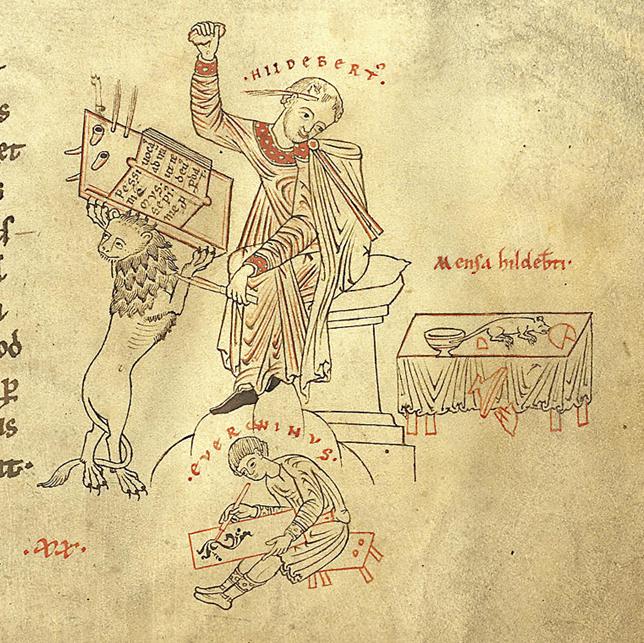 |
| Medieval mouse, Museum Meermanno, MMW, 10 B 25, Folio 24v |
 |
| Engelbart's mouse, 1963 |
That’s the title of one of the foundational essays in the history of computing: Douglas Engelbart’s Augmenting Human Intellect: A Conceptual Framework (1962). Engelbart is mostly known today as the inventor of the computer mouse, but this device was only one component of a much more radical, pioneering vision for using computers as tools to enable human beings to perform complex tasks – not just as giant calculators, which was what computers were being used as in the 1960s, but as partners with human beings in a symbiotic relationship between people and machines.
 |
| Doug Engelbart (1925-2013). Image: Doug Englebart Institute |
These visions now belong to the past. A reader today probably winces, as I do, at Bush’s assumption that the computer of the future would be fed data by ‘a whole roomful of girls armed with simple key board punches’, and it’s hard now to understand Engelbart’s excitement about the potential of cathode ray tubes. I also find it difficult to accept without question the unwavering optimism of both men in the power of technology to solve social problems and make the world a better place. But the value of Engelbart’s work was not that it produced specific technological devices and systems – although it did – but that it was a serious attempt to theorise the relationship between human beings and their tools, and to apply that theory to a research program. Engelbart expressed the symbiotic relationship between human being and machine in an acronym, H-LAM/T: ‘Human using Language, Artifacts, Methodology, in which he is Trained’. The example he used to introduce this concept was the process of writing a memo.
I was reminded of Engelbart’s ideas, and particularly of his big idea that certain tools should be designed to ‘augment human intellect’, when rereading Mary Carruthers’ classic The Book of Memory: A Study of Memory in Medieval Culture (2nd ed. 2008). Carruthers shows that the medieval book was intended as a support for memory: it was a tool for augmenting human intellect, an extension of thought. Thus the medieval book was not a data dump, a mere storage facility, but was designed to work with and to enhance the powers of the mind. For example, Carruthers argues that the medieval bestiary was not intended to be, as modern readers usually assume it was, a zoological reference book. Rather, it was a device for training the memory, teaching the reader to build a network of associations between animals, images, ordering systems (such as the alphabet), and theological concepts. It was a kind of manual for mental information management.
Engelbart’s H-LAM/T model can, in fact, be applied as usefully and easily to medieval documents as to modern digital devices, because it is not technology-dependent but rather a model for how technology ought to work. One aspect of his model that is worth noting is the centrality of the human in this symbiotic system. Much of the vision that Engelbart presented in 1962 may now seem dated, but this idea is not: that to develop effective tools, we need to pay attention to the ways in which technology is an extension of human abilities, ideas, concerns, limitations, and behaviours. Let’s go back to the mouse. The rodent for which Engelbart’s device was named was, of course, present in the workspace of many medieval readers. The image here
 |
| Prague, Capitular Library, codex A 21/1, fol. 153r (detail) |
good technology does not replace, but rather augments, the human
Skip forward nine centuries to the computer mouse and the ideas of Doug Engelbart. Some of our tools have changed, but very few of the principles behind them, because human beings of the 21st century still have a great deal in common with human beings of the 12th. Both the quill pen and the computer mouse had to be adapted to the physical structure of the human hand; the mise-en-page of the medieval scribe becomes the layout of the website designer; and you’d be annoyed, too, if someone came up behind you and ate your cheese. Engelbart’s science fiction has become reality for us, and more, because the issues that Engelbart tried to address were fundamental ones. In particular, his long view of technology, not confining it to the device-of-the-moment but thinking hard about technology as an extension of human activity, reminds us that good technology does not replace, but rather augments, the human.
Yin Liu
References
Bush, Vannevar. ‘As We May Think.’ Atlantic Monthly, 1 July 1945.
Carruthers, Mary. The Book of Memory: A Study of Memory in Medieval Culture. 2nd ed. Cambridge: Cambridge UP, 2008.
Engelbart, Douglas C. ‘Augmenting Human Intellect: A Conceptual Framework.’ Menlo Park, CA: Stanford Research Institute, 1962.
Porck, Thijs. ‘Paws, Pee and Mice: Cats Among Medieval Manuscripts.’ medievalfragments (weblog). 22 Feb 2013.
The image of the medieval mouse, with many more images and much more fascinating information, can be found at David Badke’s website, The Medieval Bestiary.
No comments :
Post a Comment